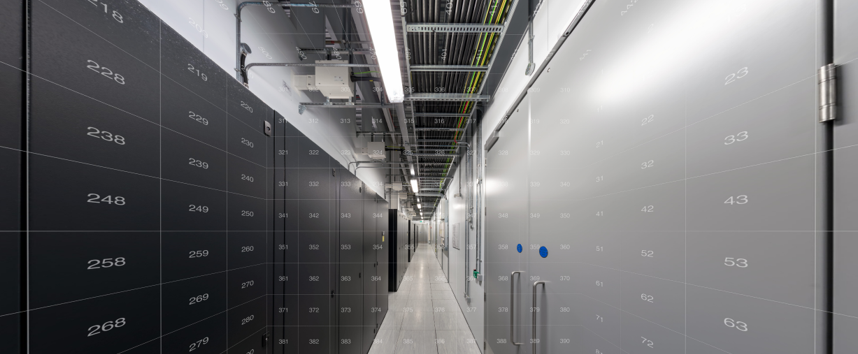Data centres like Stellium house a considerable amount of electronic equipment, such as servers, which generate significant heat. If this heat isn’t properly managed, it can lead to hardware malfunctions and failures. That’s why data centre cooling is crucial.
Some of the common systems used to cool data centres such as Stellium:
Air Conditioning: This is the most straightforward and traditional method of data centre cooling. It involves conditioning the air in the data centre to a specific temperature and humidity level. Computer Room Air Conditioning (CRAC) units and Computer Room Air Handler (CRAH) units are typically used. CRAC units work like traditional AC units, while CRAH units use chilled water to cool the air.

In-Row Data Centre Cooling: This method places the cooling system in the same row as the servers. It is more efficient as it reduces the distance that air needs to travel. The cooled air is directed exactly where it is needed, and the hot air is captured immediately.
Rear Door Heat Exchangers: These are special doors fitted to server racks that absorb the heat produced by the servers. The heat is then carried away by a coolant (usually water), which is piped through the door. This system allows hot air to be removed before it mixes with the rest of the air in the data centre.
Cold Aisle and Hot Aisle Containment: This is a method used to increase cooling efficiency and reduce energy use. Servers are placed back-to-back and front-to-front creating alternating aisles: cold aisles (front of servers, where cool air enters) and hot aisles (back of servers, where hot air exhausts). Physical barriers are used to contain either hot or cold air, improving the efficiency of the data centre cooling process.
Liquid Cooling: While less common due to its complexity, high-performance data centres such as Stellium use liquid cooling methods, where the coolant is brought directly into contact with the server components. It can be significantly more efficient than air cooling. Two main methods of liquid cooling are immersion cooling and direct-to-chip cooling.
Free Cooling: This is an energy-efficient method that uses external environmental conditions to cool the data centre. It can involve air-side economization (using cool outside air), or water-side economization (using bodies of water or cooler external air to chill water).
Data Centre cooling strategies will depend on various factors like the location of the data centre, the local climate, and the power density of the servers. It’s also important to monitor the temperature and humidity in a data centre constantly, using Data Center Infrastructure Management (DCIM) software or other similar tools, to ensure that conditions stay within optimal ranges and SLA. Colocation providers such as Stellium offer SLAs that guarantee levels of availability, power, cooling, and other factors. Stellium offers its clients data centre SLAs on Security at 100%, Cooling at 100%, and Power at 99.982%. We provide SLAs to each client outlining the expected availability of each service. Unplanned outages that lead to decreased availability from the levels set out in the SLAs lead to credits on those services during the next period.
Data centre cooling systems represent a significant portion of a data centre’s (and their clients) operational costs, and energy-efficient designs and operations are a high priority in contemporary data centre management.
Following the hottest June on record in 2023, where temperatures in London exceeded 32 deg C (June 2023) with no sign of reducing in future, data centre users need to look North for their UK data centre requirements.
Stellium’s Tier 3+ data centre in Newcastle operates in much less hostile temperatures, rarely exceeding 22 deg C (June 2023).
The consequences for your business are lower cooling bills and a cooling system that always works well within its design parameters.
Chat with our data centre team today to discuss your data centre business requirements.
